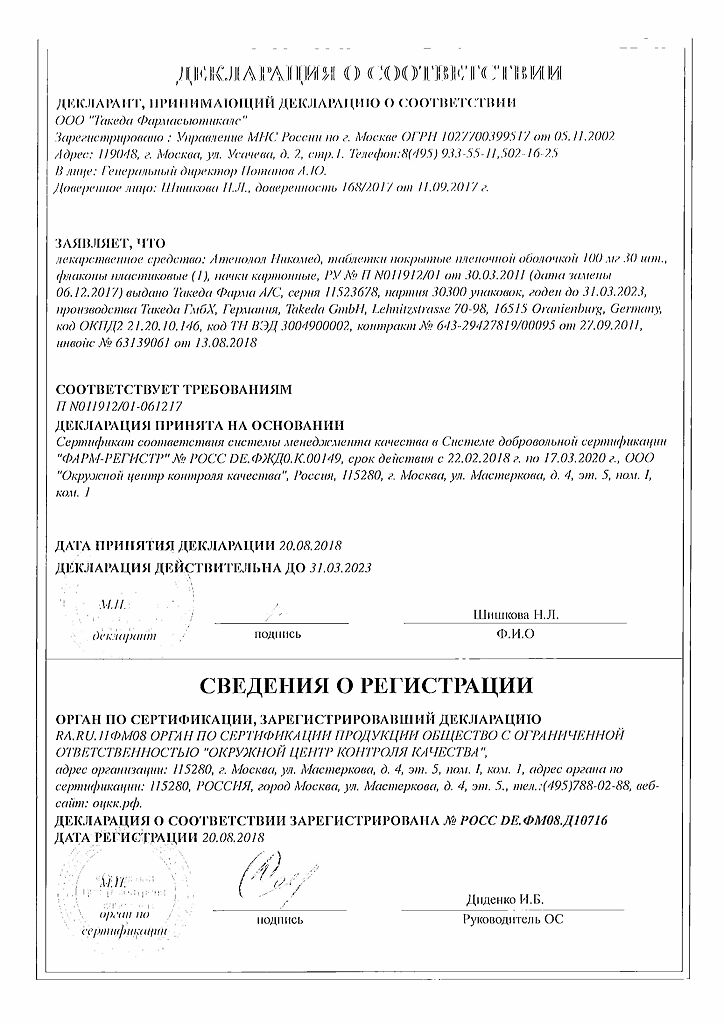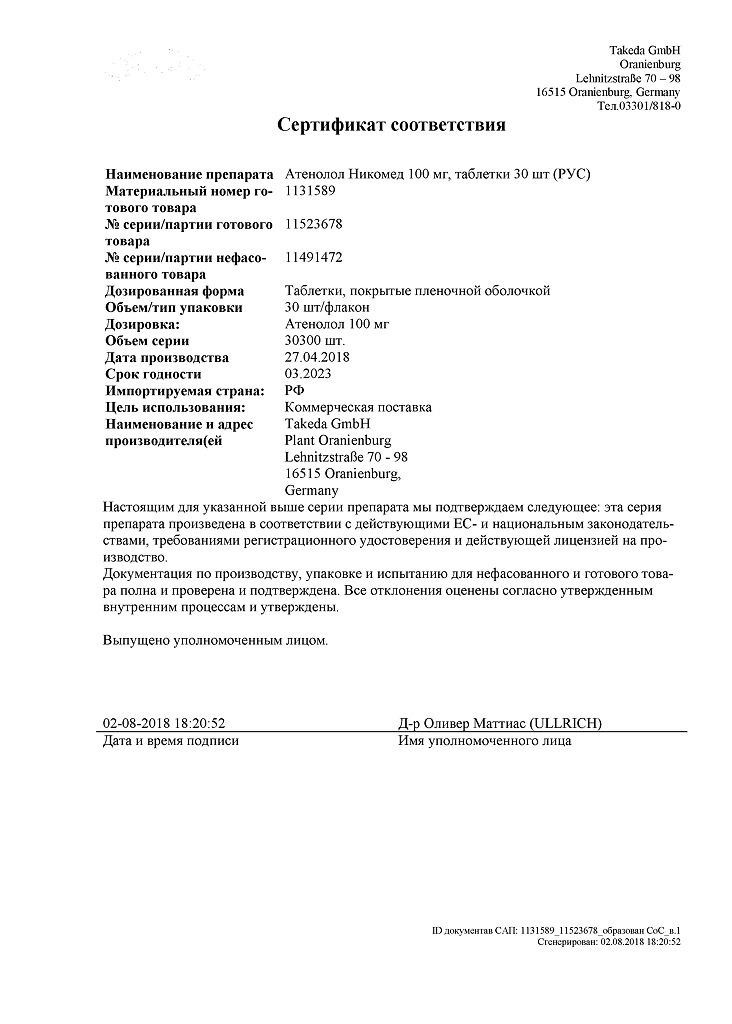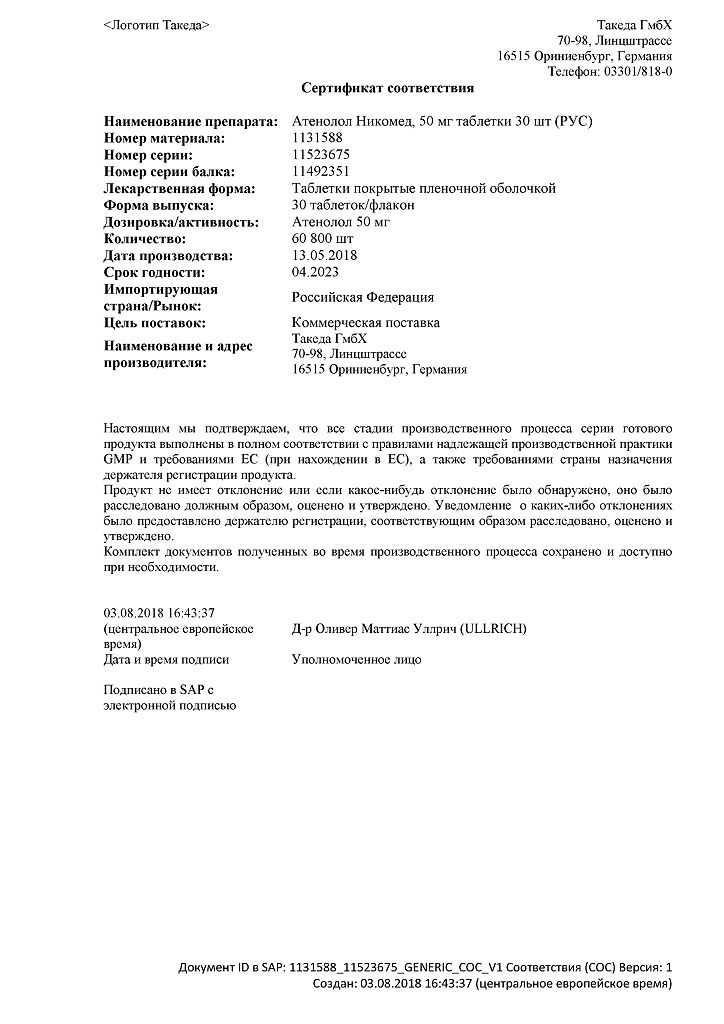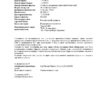No products in the cart.
Atenolol Nicomed, tablets 100 mg, 30 pcs.
€1.00
Out of stock
(E-mail when Stock is available)
Description
Atenolol Nicomed has antianginal, antihypertensive and antiarrhythmic effects.
The cardioselective beta1-adrenoblocker has no membrane stabilizing and intrinsic sympathomimetic activity. It has antihypertensive, antianginal and antiarrhythmic effects. In low doses it blocks beta1-adrenoceptors of heart, decreases catecholamine-stimulated formation of cyclic adenosine monophosphate (cAMP) from adenosine triphosphate (ATP), reduces intracellular calcium ions flow, produces negative chrono-, dromo-, batmo- and inotropic effects (decreases heart rate), inhibits conduction and excitability, reduces myocardial contractility.)
The total peripheral vascular resistance at the beginning of administration of beta-adrenoblockers (in the first 24 hours after oral administration) increases (as a result of reciprocal increase of alpha-adrenoreceptor activity and elimination of beta2-adrenoreceptor stimulation) which returns to baseline in 1-3 days and decreases with long-term administration.
The antihypertensive effect is associated with decrease of the minute blood flow volume, decrease of renin-angiotensin-aldosterone system activity (of greater importance for patients with initial renin hypersecretion), sensitivity of aortic arch baroreceptors (no increase of their activity in response to BP decrease and influence on the central nervous system.
The antihypertensive effect is realized by decrease of both systolic and diastolic blood pressure, decrease of stroke and minute volume of blood circulation. In medium therapeutic doses, it has no effect on the tone of the peripheral arteries. The antihypertensive effect lasts for 24 hours and with regular use is stabilized by the end of 2 weeks of treatment.
The antianginal effect is determined by decreasing myocardial oxygen demand as a result of decreasing HR (prolongation of diastole and improvement of myocardial perfusion) and contractility and decreasing myocardial sensitivity to sympathetic stimulation. It decreases HR at rest and during physical activity. By increasing left ventricular end-diastolic pressure and increasing ventricular muscle fiber stretch may increase oxygen demand, especially in patients with chronic heart failure.
The antiarrhythmic effect is caused by the elimination of arrhythmogenic factors (tachycardia, increased activity of the sympathetic nervous system, increased content of CAMF, arterial hypertension), reduction of the rate of spontaneous excitation of sinus and ectopic pacemakers and slowing of atrioventricular conduction. Inhibition of impulse conduction is observed predominantly in antegrade and, to a lesser extent, in retrograde direction through the atrioventricular (AV) node and via additional pathways.
The bronchodilator effect of isoprenaline is practically not impaired.
In contrast to non-selective beta-adrenoblockers when administered in medium therapeutic doses, it has less pronounced effect on organs containing beta2-adrenoreceptors (pancreas, skeletal muscles, smooth muscle of peripheral arteries, bronchi and uterus) and on carbohydrate metabolism; intensity of atherogenic action does not differ from that of propranolol. To a lesser extent, it has negative butmo-, chrono-, ino- and dromotropic effects. When used in high doses (more than 100 mg/day) it has a blocking effect on both beta-adrenoreceptor subtypes.
The negative chronotropic effect appears 1 hour after intake, reaches its maximum after 2-4 hours and lasts up to 24 hours.
Pharmacokinetics
Gastrointestinal absorption is rapid, incomplete (45-60%), bioavailability is 40-50%, time to reach Cmax in plasma – 2-4 hours. It penetrates poorly through the blood-brain barrier, passes in small amounts through the placental barrier and into breast milk. Binding with blood plasma proteins is relatively low and is less than 5%.
It is practically not metabolized in the liver. T1/2 from blood plasma is 6-8 h (increases in elderly patients). It is excreted by the kidneys through glomerular filtration (85-100% unchanged).
Impaired renal function is accompanied with prolongation of T1/2 and cumulation (dose decreasing is necessary): in creatinine clearance (CK) less than 35 ml/min/1.73 m2 T1/2 is 16-27 h, in CK less than 15 ml/min – more than 27 h, in anuria it prolongs to 144 h. It is excreted during hemodialysis.
Indications
Indications
Arterial hypertension, CHD, heart failure palpitations, cardiac arrhythmias.
Active ingredient
Active ingredient
Composition
Composition
The active ingredient is atenolol 100 mg.
How to take, the dosage
How to take, the dosage
The dosage regimen of Atenolol Nicomed is established individually. The usual dose for adults is oral, at the beginning of treatment is 25-50 mg once a day. If necessary, the dose is gradually increased. Maximum dose: adults when taken orally is 200 mg/day in 1 or 2 doses.
Interaction
Interaction
The simultaneous use of diuretics increases the antihypertensive effect. When concomitant use of agents for inhalation anesthesia, the risk of increased cardiodepressant effect and development of arterial hypotension increases. There are reports of bradycardia and arterial hypotension when concomitant use of alcuronium chloride. Concomitant use of verapamil increases negative inotropic effect, develops bradycardia, bradyarrhythmia, pronounced conduction disorders; cases of postural hypotension, dizziness, left ventricular failure, lethargy have been described. Pharmacokinetic parameters of atenolol are not significantly changed under the influence of verapamil, although there has been described a case of increasing AUC of atenolol.
Special Instructions
Special Instructions
Atenolol Nicomed should be used with caution in diabetes mellitus, COPD (including Bronchial asthma, pulmonary emphysema), metabolic acidosis, hypoglycemia; history of allergic reactions, chronic heart failure (compensated), peripheral artery obliterating diseases (intermittent claudication, Raynaud’s syndrome), pheochromocytoma, liver failure, chronic renal insufficiency, myasthenia gravis, thyrotoxicosis, depression (including history of depression), psoriasis and depression.anamnesis), psoriasis, pregnancy, elderly patients, pediatrics (efficacy and safety are not defined). Administration of atenolol may decrease tear fluid production, which is important for patients who use contact lenses.
Contraindications
Contraindications
Side effects
Side effects
CNS disorders: bradycardia, palpitation, myocardial conduction disturbances, AV block (up to cardiac arrest), arrhythmias, weakening of myocardial contractility, development (aggravation) of CHF, orthostatic hypotension, angiospasm symptoms (coldness of the lower extremities, Raynaud’s syndrome), vasculitis, chest pain.
CNS disorders: asthenia, weakness, dizziness, headache, drowsiness or insomnia, “nightmares” dreams, depression, anxiety, mental confusion or short-term memory loss, hallucinations, decreased ability to concentrate, decreased reaction rate, paresthesias of extremities (in patients with “intermittent” claudication and Raynaud’s syndrome), muscle weakness, seizures.
Senses: visual impairment, decreased tear fluid secretion, dry and painful eyes, conjunctivitis.
Digestive system disorders: dry mucous membranes of the mouth, nausea, vomiting, abdominal pain, constipation or diarrhea, changes in taste.
Respiratory system: nasal congestion, difficulty in breathing when prescribed in high doses (loss of selectivity) and/or in susceptible patients – laryngo- and bronchospasm.
Endocrine system: hyperglycemia (in patients with type 2 diabetes), hypoglycemia (in patients receiving insulin), hypothyroidism.
Allergic reactions: skin itching, rash, urticaria.
Skin disorders: increased sweating, hyperemia of the skin, exacerbation of psoriasis symptoms, psoriasis-like skin rash, reversible alopecia.
Laboratory parameters: thrombocytopenia (unusual bleeding and hemorrhage), agranulocytosis, leukopenia, increased activity of “liver” enzymes, hyperbilirubinemia.
Fetal effects: intrauterine growth retardation, hypoglycemia, bradycardia.
Others: back pain, arthralgia, decreased libido, decreased potency, “withdrawal” syndrome (increased angina pectoris attacks, increased BP).
Overdose
Overdose
Symptoms: pronounced bradycardia, AV block of II-III degree, increasing symptoms of heart failure, excessive BP decrease, difficulty breathing, bronchospasm, dizziness, fainting, arrhythmia, ventricular extrasystole, cyanosis of finger nails or palms, seizures.
Treatment: gastric lavage and administration of adsorptive drugs; in case of bronchospasm inhalation or intravenous administration of the beta 2-adrenomimetic salbutamol is indicated.
Pregnancy use
Pregnancy use
Atenolol penetrates the placental barrier, therefore, its use during pregnancy is possible only if the estimated benefit to the mother exceeds the possible risk to the fetus. Atenolol is excreted with breast milk, therefore it is recommended to stop breastfeeding if use during lactation is necessary.
Similarities
Similarities
Additional information
| Shelf life | 5 years. |
|---|---|
| Conditions of storage | Store at a temperature not exceeding 25 ° C. |
| Manufacturer | Takeda GmbH, Germany |
| Medication form | pills |
| Brand | Takeda GmbH |
Related products
Buy Atenolol Nicomed, tablets 100 mg, 30 pcs. with delivery to USA, UK, Europe and over 120 other countries.





















